Using the OCAL 3.0 Collimator is proving to be more difficult than I thought. I have tried collimating with and without reducer, with and without OAG and with and without the 21mm filter holder. I cannot seem to get the red circle to line up with the white area. When I line up the crosshairs, the blue circle and the green circle, the red circle is not fully concentric. Does anyone have experience getting the Edge collimated and then taking it outside for a star check? My stars are not good enough for astrophotgraphy and I am beginning to wonder if it's my lack of skill or the collimator itself just isn't accurate enough. If it's not, what are my options for indoor collimation? Standing outside and trying to collimate at 1422mm or 2032mm focal length while the star is moving rapidly out of the field of view is something I am not going to spend time doing. I'd rather use refractors. But if I can get this collimated indoors, I'd be happy. Thanks! See images: (bottom image is same as top image but the gain is reduced so the red circle issue is more visible) 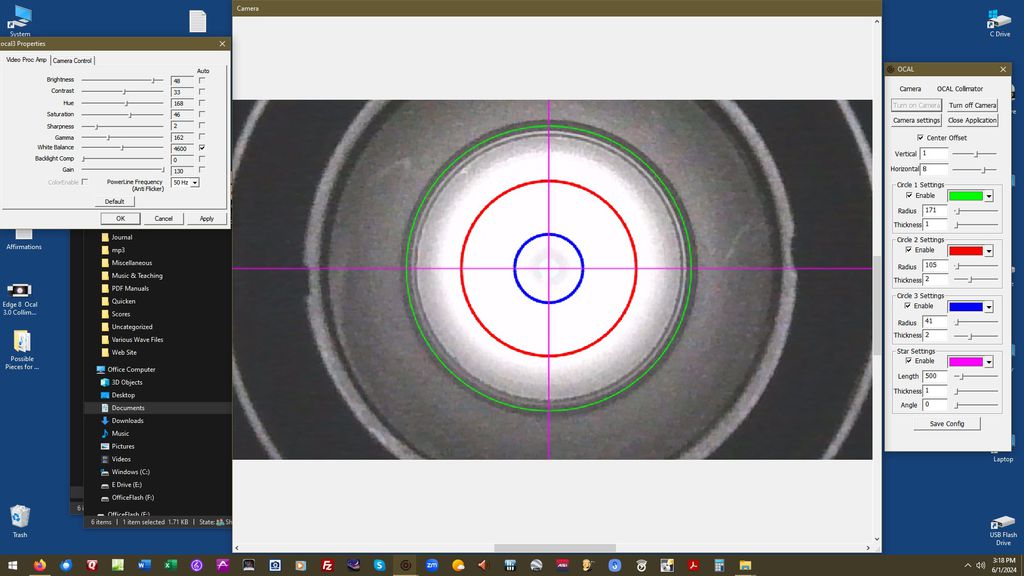 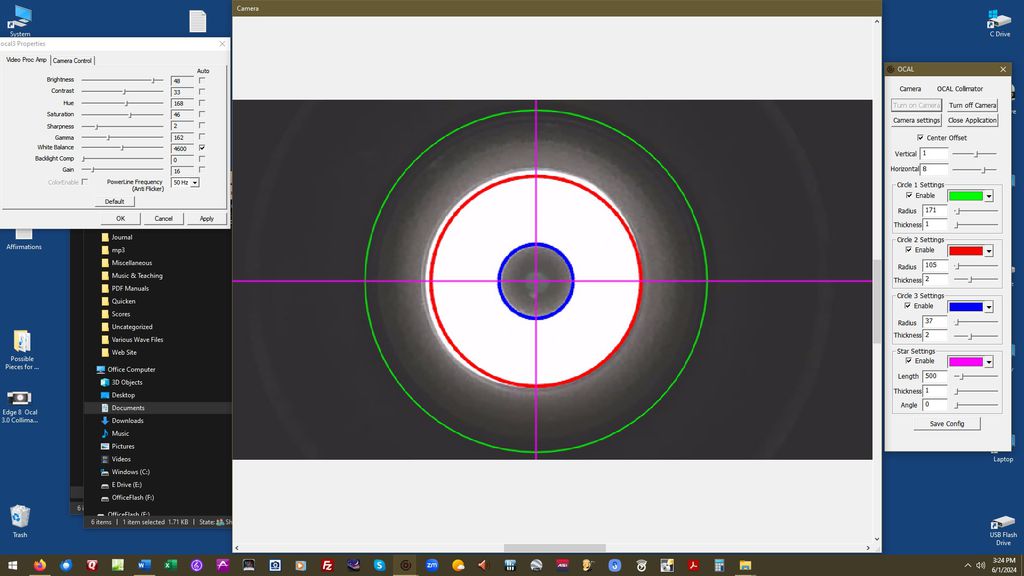 |
You cannot like this item. Reason: "ANONYMOUS".
You cannot remove your like from this item.
Editing a post is only allowed within 24 hours after creating it.
You cannot Like this post because the topic is closed.
Copy the URL below to share a direct link to this post.
This post cannot be edited using the classic forums editor.
To edit this post, please enable the "New forums experience" in your settings.
I don't have an OCAL so I cannot offer advice on that, but I managed to collimate my EdgeHD 8" pretty well using the defocused brightish star method that Dylan O'Donnell explained on his YouTube channel. It helps a lot if you have something like Bob's Knobs on your scope, since that removes the need for fiddling with Allen keys in the dark. I had also tried to collimate during daytime inside the house but found that that was not very successful at all.
|
You cannot like this item. Reason: "ANONYMOUS".
You cannot remove your like from this item.
Editing a post is only allowed within 24 hours after creating it.
You cannot Like this post because the topic is closed.
Copy the URL below to share a direct link to this post.
This post cannot be edited using the classic forums editor.
To edit this post, please enable the "New forums experience" in your settings.
I didn't have much luck with my ocal. What really got me close was using an artificial star during the day. I put it on the furthest part of my house, which was a lot closer than most people recommend. Used a pin prick in tin foil over an LED light. Then got it pretty close. Then the next night I was able to fine tune it to be pretty good.
|
You cannot like this item. Reason: "ANONYMOUS".
You cannot remove your like from this item.
Editing a post is only allowed within 24 hours after creating it.
You cannot Like this post because the topic is closed.
Copy the URL below to share a direct link to this post.
This post cannot be edited using the classic forums editor.
To edit this post, please enable the "New forums experience" in your settings.
I don’t use OCAL but tribathinov. Works like a charm I get really great star!
|
You cannot like this item. Reason: "ANONYMOUS".
You cannot remove your like from this item.
Editing a post is only allowed within 24 hours after creating it.
You cannot Like this post because the topic is closed.
Copy the URL below to share a direct link to this post.
This post cannot be edited using the classic forums editor.
To edit this post, please enable the "New forums experience" in your settings.
I struggled with this too until a few weeks ago. I tried Bob's knobs but went back to socket head cap screws. I found the Bob's knobs were too hard to move a small amount. I got close with a defocused star, but when I started using a tribathinov mask I was able to get it dialed in and now I get the best stars ever from this scope.
|
You cannot like this item. Reason: "ANONYMOUS".
You cannot remove your like from this item.
Editing a post is only allowed within 24 hours after creating it.
You cannot Like this post because the topic is closed.
Copy the URL below to share a direct link to this post.
This post cannot be edited using the classic forums editor.
To edit this post, please enable the "New forums experience" in your settings.
I have struggled with refocused stars and the OCAL. By far the easiest and most precise method is the triBathinov mask. You can get one on Etsy.
|
You cannot like this item. Reason: "ANONYMOUS".
You cannot remove your like from this item.
Editing a post is only allowed within 24 hours after creating it.
You cannot Like this post because the topic is closed.
Copy the URL below to share a direct link to this post.
This post cannot be edited using the classic forums editor.
To edit this post, please enable the "New forums experience" in your settings.
THIBAUD Lucas:
I don’t use OCAL but tribathinov. Works like a charm I get really great star! +1 for a tri-bahtinov mask. I also replaced the screws with Bob's Knobs (because who likes fumbling with a screwdriver in the dark). It's been a while since I used the OCAL and as I recall, it just gets you in the ballpark. The last time I used the tri-bahtinov, I think it took me all of 5 minutes to collimate.
|
You cannot like this item. Reason: "ANONYMOUS".
You cannot remove your like from this item.
Editing a post is only allowed within 24 hours after creating it.
You cannot Like this post because the topic is closed.
Copy the URL below to share a direct link to this post.
This post cannot be edited using the classic forums editor.
To edit this post, please enable the "New forums experience" in your settings.
Hi, Jerry. I've not got an OCAL but did seriously consider something like this because of all the struggle I have had with collimation of my EdgeHD 8". Even with perfectly centred defocused stars (doughnuts), I had distorted results; my supplier was not much help, suggesting that it must be me and not the scope. All of the videos (including Dylan's very good one) seem to assume that the corrector etc. are all properly located and that the only issue is the secondary mirror; I believe that this is an assumption to be challenged. I understand other tools such as the HOTECH are intended to help adjust any such problems. Your results hint that you may need to do more than just adjust the secondary (see below for more on that) for the OCAL to produce results. And in all of the videos I've seen on collimation by using the centred defocussed stars method, it presents as far easier and less frustrating than the reality I have experienced. Here is where I got to (just a month ago) and am now fairly happy. See some photos below. - I do it outdoors at night with a bright star.
- Install knobs instead of screws. These are so much easier to adjust whilst standing beside the scope outdoors in the dark, and you have no risk of scratching the glass with a misplaced screwdriver. I got some knobs from the local hardware store; the thread on mine is M3. Fine adjustments are much easier too.
- Get a tri-Bahtinov mask - this piece of magic is the game changer (at least for me, and it seems others who have responded to your post too).
- Polar align the mount (EQ in my case) so that it can accurately track a star across the sky (which eliminates your stated problem of the star going out of the field of view).
- Find a super bright star - Sirius works for me. I use an astro camera but visually will work too of course. With the camera (looping the exposures), you can be adjusting knobs whilst looking at the screen image instead of moving back and forth to the eyepiece.
- NB: If you are using an astro camera that has cooling, leave the cooling Off. The fan vibrations can also be a source of star distortion. See below for more on this.
- Before doing anything further, wind the mirror focus knob 8-10 turns out and back either side of your current (roughly focused) position. This was suggested on one forum, the idea being to ensure that nothing is sticking. I did some image tests pre and post doing this and it did indeed make a huge difference.
- Focus as sharply as possibly ( I have an electronic focuser, so I do an autofocus run as well). This will ensure that the tri-Bahtinov mask is showing only collimation errors and not focusing errors (for which the original Bahtinov mask is designed). Unfocussed stars will cause the tri-Bahtinov to show non-centred spikes, even when perfectly collimated. You want it super-well focused so that non-centred spikes are attributable solely to collimation error.
- Adjust the knobs until you have all the spikes centred (you can see plenty of examples online). Apropos my statement above, expect some frustration and hair pulling to get this completely nailed. It involves releasing two screws and tightening the opposite one several times, eventually just a tiny fraction of a turn. You also have to work out which screw for which spike; there are some good videos online for this.
After all that, my stars are nice and round and sharp like never before; better than out of the box (which was not great to begin with). But here is the thing. When I defocus a star now, the doughnut is way off centre. This leads me to suspect that my OTA has some other problem such as an off-centre corrector. I've never adjusted that and will likely not do so without some expert help. From your post, it seems possible that you may have a similar challenge. Again, a lot of collimation techniques assume only the secondary needs adjusting and that everything else is in its proper place. I suspect that for some OTAs, this may be a flawed assumption. My stars are sharp and round now, so I have the outcome I want, which probably means I should not fiddle with the corrector or anything else. Also, I do not use the mirror locking screws on the EdgeHD, lest these affect the angle of the mirror. I've not had any shift in collimation during meridian flip (at least in my final images) so figure this is fine. If you are using an auto-focuser attached to the mirror, you need to leave them unlocked anyway. You may also find, if you are imaging, that even perfectly collimated, with some cooled cameras you can have stretched stars with even relatively short exposures. Fan vibration is a known source - there are online discussions and video on this. I changed the fan on my ASI2600MM to a Fractal Design Silent Series R3 50mm which I found on Amazon. Everyone also seems to install rubber mounts, but I have not (as they've still not arrived) and with the results I have, I believe I may not need them. I hope that helps a bit, Jerry. If my experience is anything close to yours, it sort of suggests that the OCAL may not be helping as much as it should which is a bit of a bummer. A tri-Bahtinov mask is cheap, and I suggest well worth trying. Some Images: Knobs from the local hardware store. Cheaper than Bob's and functionally identical. You'll need three of course. They are M3 on mine but I believe they can be imperial on some OTAs (perhaps USA). 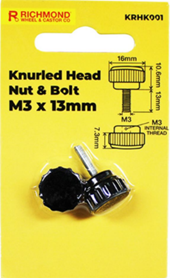 Installed on the OTA. Beautiful. 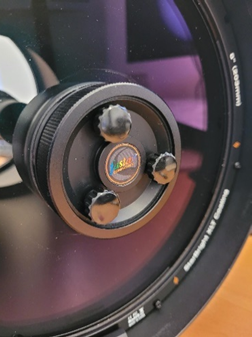 Tri-Bahtinov. Get this design as it easily goes on and off with the raised centre ring to hold on to, and sits over the adjuster screw area.  Tri-Bahtinov star spikes. This is mid-process. You can see that the N/S and NE/SW are not yet centred; the NW/SE are pretty good. This is about where it gets super fiddly with very small adjustments. 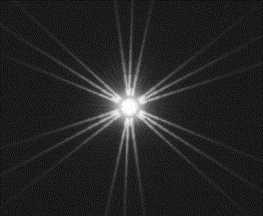 All the best. Paul
|
You cannot like this item. Reason: "ANONYMOUS".
You cannot remove your like from this item.
Editing a post is only allowed within 24 hours after creating it.
You cannot Like this post because the topic is closed.
Copy the URL below to share a direct link to this post.
This post cannot be edited using the classic forums editor.
To edit this post, please enable the "New forums experience" in your settings.
I read your note and had a little chuckle. If you want things to run as smooth as silk, you may have chosen the wrong hobby.. The reply by others are excellent. My 8 Hd drove me nuts. Even with the locks on the mirror was loose from the factory. Finaliy I removed the corrector plate and pushed on the mirror and the suspension compliance was too soft. Sent it back and Celestron’ got fixed. Just a comment, Collimating in doors in an horizontal position and setting up outside at a totally different elevation is going to change the collimation to some degree on a SCT. Also, everything must be right. Turn the focus knob CCW, tighten the locks. If you are using a camera (the best method) make sure there is absolutely no sag in the imaging train. (No wiggle) And get a worm coat and hat. Chris
|
You cannot like this item. Reason: "ANONYMOUS".
You cannot remove your like from this item.
Editing a post is only allowed within 24 hours after creating it.
You cannot Like this post because the topic is closed.
Copy the URL below to share a direct link to this post.
This post cannot be edited using the classic forums editor.
To edit this post, please enable the "New forums experience" in your settings.
I use an artificial star indoors, collimate in horizontal position with the mirror locked.
The star is about 15 meters away from the front plate.
I use a camera, with 1 or 2 seconds shots to average out the turbulence effect caused by potential air waves indoors. Note that this is also useful when collimating on the sky. It may seem counterintuitive, but this is the only way I found to clearly distinguish the Airy rings in and out of focus.
The camera I use has no fan, temperature rising is not a concern with my procedure.
I also run autofocus after each collimating step.
Using knobs is also very helpful, provided you proceed gently and do not lock them tight. Close to the spot point, your adjustments will be tiny.
When complete, I confirm collimation on the sky, with a not-too-bright star. I never had to adjust so far.
Note I don’t unlock the mirror once collimated.
All advices given in the thread above are good.
It’s really a matter of patience: it can be frustrating indeed. If you’re not satisfied with the results, just start over, step by step.
My 2 cents…
|
You cannot like this item. Reason: "ANONYMOUS".
You cannot remove your like from this item.
Editing a post is only allowed within 24 hours after creating it.
You cannot Like this post because the topic is closed.
Copy the URL below to share a direct link to this post.
This post cannot be edited using the classic forums editor.
To edit this post, please enable the "New forums experience" in your settings.
Paul Larkin:
Hi, Jerry.
I've not got an OCAL but did seriously consider something like this because of all the struggle I have had with collimation of my EdgeHD 8". Even with perfectly centred defocused stars (doughnuts), I had distorted results; my supplier was not much help, suggesting that it must be me and not the scope.
All of the videos (including Dylan's very good one) seem to assume that the corrector etc. are all properly located and that the only issue is the secondary mirror; I believe that this is an assumption to be challenged. I understand other tools such as the HOTECH are intended to help adjust any such problems. Your results hint that you may need to do more than just adjust the secondary (see below for more on that) for the OCAL to produce results. And in all of the videos I've seen on collimation by using the centred defocussed stars method, it presents as far easier and less frustrating than the reality I have experienced.
Here is where I got to (just a month ago) and am now fairly happy. See some photos below.
- I do it outdoors at night with a bright star.
- Install knobs instead of screws. These are so much easier to adjust whilst standing beside the scope outdoors in the dark, and you have no risk of scratching the glass with a misplaced screwdriver. I got some knobs from the local hardware store; the thread on mine is M3. Fine adjustments are much easier too.
- Get a tri-Bahtinov mask - this piece of magic is the game changer (at least for me, and it seems others who have responded to your post too).
- Polar align the mount (EQ in my case) so that it can accurately track a star across the sky (which eliminates your stated problem of the star going out of the field of view).
- Find a super bright star - Sirius works for me. I use an astro camera but visually will work too of course. With the camera (looping the exposures), you can be adjusting knobs whilst looking at the screen image instead of moving back and forth to the eyepiece.
- NB: If you are using an astro camera that has cooling, leave the cooling Off. The fan vibrations can also be a source of star distortion. See below for more on this.
- Before doing anything further, wind the mirror focus knob 8-10 turns out and back either side of your current (roughly focused) position. This was suggested on one forum, the idea being to ensure that nothing is sticking. I did some image tests pre and post doing this and it did indeed make a huge difference.
- Focus as sharply as possibly ( I have an electronic focuser, so I do an autofocus run as well). This will ensure that the tri-Bahtinov mask is showing only collimation errors and not focusing errors (for which the original Bahtinov mask is designed). Unfocussed stars will cause the tri-Bahtinov to show non-centred spikes, even when perfectly collimated. You want it super-well focused so that non-centred spikes are attributable solely to collimation error.
- Adjust the knobs until you have all the spikes centred (you can see plenty of examples online). Apropos my statement above, expect some frustration and hair pulling to get this completely nailed. It involves releasing two screws and tightening the opposite one several times, eventually just a tiny fraction of a turn. You also have to work out which screw for which spike; there are some good videos online for this.
After all that, my stars are nice and round and sharp like never before; better than out of the box (which was not great to begin with).
But here is the thing. When I defocus a star now, the doughnut is way off centre. This leads me to suspect that my OTA has some other problem such as an off-centre corrector. I've never adjusted that and will likely not do so without some expert help. From your post, it seems possible that you may have a similar challenge. Again, a lot of collimation techniques assume only the secondary needs adjusting and that everything else is in its proper place. I suspect that for some OTAs, this may be a flawed assumption.
My stars are sharp and round now, so I have the outcome I want, which probably means I should not fiddle with the corrector or anything else.
Also, I do not use the mirror locking screws on the EdgeHD, lest these affect the angle of the mirror. I've not had any shift in collimation during meridian flip (at least in my final images) so figure this is fine. If you are using an auto-focuser attached to the mirror, you need to leave them unlocked anyway.
You may also find, if you are imaging, that even perfectly collimated, with some cooled cameras you can have stretched stars with even relatively short exposures. Fan vibration is a known source - there are online discussions and video on this. I changed the fan on my ASI2600MM to a Fractal Design Silent Series R3 50mm which I found on Amazon. Everyone also seems to install rubber mounts, but I have not (as they've still not arrived) and with the results I have, I believe I may not need them.
I hope that helps a bit, Jerry. If my experience is anything close to yours, it sort of suggests that the OCAL may not be helping as much as it should which is a bit of a bummer. A tri-Bahtinov mask is cheap, and I suggest well worth trying.
Some Images:
Knobs from the local hardware store. Cheaper than Bob's and functionally identical. You'll need three of course.
They are M3 on mine but I believe they can be imperial on some OTAs (perhaps USA).

Installed on the OTA. Beautiful.

Tri-Bahtinov. Get this design as it easily goes on and off with the raised centre ring to hold on to, and sits over the adjuster screw area.

Tri-Bahtinov star spikes. This is mid-process. You can see that the N/S and NE/SW are not yet centred; the NW/SE are pretty good. This is about where it gets super fiddly with very small adjustments.

All the best.
Paul Thank you Paul for the detailed info. Yes, I know about the Tri-Bahtinov masks, I use them regularly with my refractors for focusing, they work great. I also have Bob's Knobs on the Edge 8. Next time I can, I'll get out and do auto focusing with the ZWO EAF and then go to a bright star and try the mask. If I can get that to work without wasting more than 10 minutes or so, I'll keep the SCT. Otherwise I'll be content with the 100mm and 130mm refractors, Best, Jerry
|
You cannot like this item. Reason: "ANONYMOUS".
You cannot remove your like from this item.
Editing a post is only allowed within 24 hours after creating it.
You cannot Like this post because the topic is closed.
Copy the URL below to share a direct link to this post.
This post cannot be edited using the classic forums editor.
To edit this post, please enable the "New forums experience" in your settings.
Chris Strang:
I read your note and had a little chuckle. If you want things to run as smooth as silk, you may have chosen the wrong hobby.. The reply by others are excellent. My 8 Hd drove me nuts. Even with the locks on the mirror was loose from the factory. Finaliy I removed the corrector plate and pushed on the mirror and the suspension compliance was too soft. Sent it back and Celestron’ got fixed. Just a comment, Collimating in doors in an horizontal position and setting up outside at a totally different elevation is going to change the collimation to some degree on a SCT. Also, everything must be right. Turn the focus knob CCW, tighten the locks. If you are using a camera (the best method) make sure there is absolutely no sag in the imaging train. (No wiggle) And get a worm coat and hat. Chris I know how difficult astrophotography can be. Things hardly ever (but sometimes they do!) run smooth as silk. My experience is that when I take out my refractors, I almost always end up with (unless weather intervenes) with good data. But with the Edge I am always struggling with collimation. I am in the process of putting a 130mm refractor at a remote site and will probably do 80% of my imaging remotely, so if the Edge collimation ordeal ends up being too time-consuming, I may just sell it and and use refractors. I wasn't collimating in a horizontal position, but rather indoors on a tripod as though the telescope is aimed at Polaris.
|
You cannot like this item. Reason: "ANONYMOUS".
You cannot remove your like from this item.
Editing a post is only allowed within 24 hours after creating it.
You cannot Like this post because the topic is closed.
Copy the URL below to share a direct link to this post.
This post cannot be edited using the classic forums editor.
To edit this post, please enable the "New forums experience" in your settings.
I apologizes for the sarcasm. To the point. I also am of the opinion that not all HD8’s are created equal. If I do a good collimation and remove everything from the back, then look directly into the rear of the tube the secondary/primary shadow is not exactly centered, but when looking into the front from 2 meters all reflection rings appear perfectly concentric; suggesting that the primary and secondary are not completely coaxial.. The optics start to get complex at this point but the spherical mirror design is a little forgiving. A note; I belong to a group in South East Michigan, one member is a world class imager using the same tub.
|
You cannot like this item. Reason: "ANONYMOUS".
You cannot remove your like from this item.
Editing a post is only allowed within 24 hours after creating it.
You cannot Like this post because the topic is closed.
Copy the URL below to share a direct link to this post.
This post cannot be edited using the classic forums editor.
To edit this post, please enable the "New forums experience" in your settings.
Hi, Chris. Given what you've said, would it be fair to say that even not centred, with what appears collimated using tri-Bahtinov will in fact be as good as it needs to be? Cheers. Paul Chris Strang:
I apologizes for the sarcasm. To the point. I also am of the opinion that not all HD8’s are created equal. If I do a good collimation and remove everything from the back, then look directly into the rear of the tube the secondary/primary shadow is not exactly centered, but when looking into the front from 2 meters all reflection rings appear perfectly concentric; suggesting that the primary and secondary are not completely coaxial.. The optics start to get complex at this point but the spherical mirror design is a little forgiving. A note; I belong to a group in South East Michigan, one member is a world class imager using the same tub. Hi, Chris. Given this, would it be fair to say that even if secondary/primary are not precicely centred, what looks well collimated using the tri-Bahtinov will in fact be as good as it needs to be? Cheers. Paul
|
You cannot like this item. Reason: "ANONYMOUS".
You cannot remove your like from this item.
Editing a post is only allowed within 24 hours after creating it.
You cannot Like this post because the topic is closed.
Copy the URL below to share a direct link to this post.
This post cannot be edited using the classic forums editor.
To edit this post, please enable the "New forums experience" in your settings.
Hi, I have the OCAL 3.0 Collimator and an EDGE 8HD, and found it gets you 80% collimated at best. If your C8 collimation is way out, then you may have to carefully remove the secondary and visually check how level the mirror is. The starting point is level with the screws mostly in, so the mirror is closest to the holding plate. Then I use the OCAL to line things up best as possible. Then sometimes I have used a red led light 20+ meters away and collimate during the day. But mostly now I can do this during the night with the out of focus star. The trick I have found is, seeing must be good or else you just make it worse. Choose a bright star at least 45 degrees alt. Then using the below instructions, I can collimate near perfect in 5mins. If you ever guess the turns then you'll get into trouble. Doesn't work I tried lol! If you have a good mount then it's easier to return the star back to center after adjustments. Key points re below is, star must be centered, where does the out of shape donut point to? using your hand in front of C8 with live camera feed etc is it in line with 1 of the 3 screws? if yes then CCW turn on the aligned screw, if no then CW turn of the opposite side screw. always always always small adjustments!! anything more is guessing and you'll get into trouble!  good luck! 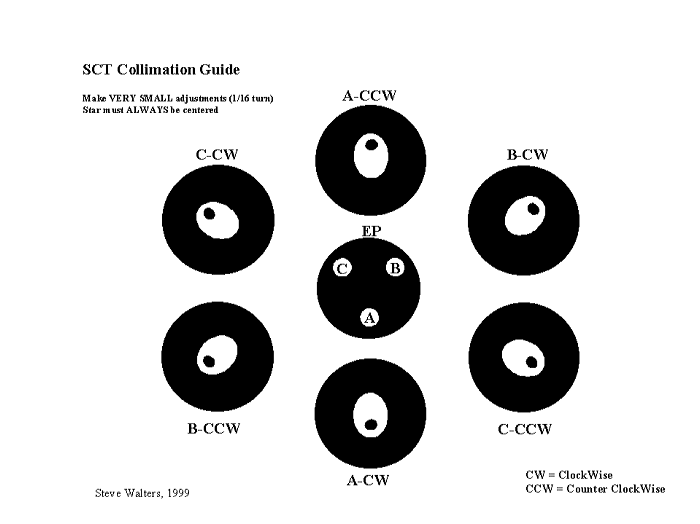 |
You cannot like this item. Reason: "ANONYMOUS".
You cannot remove your like from this item.
Editing a post is only allowed within 24 hours after creating it.
You cannot Like this post because the topic is closed.
Copy the URL below to share a direct link to this post.
This post cannot be edited using the classic forums editor.
To edit this post, please enable the "New forums experience" in your settings.
Paul,I am satisfied with my scope’s performance. My scope is seldom in perfect collocation because of my long and heavy imaging train. My stars are round with little or no eccentricity. But, I don’t shoot star clusters and my skies are Bortle 8 so it may be an issue with others.. If my stars are not perfect I look first for guiding problems. backlash, polar alignment, and balance. Also, I have a good friend with a remote observatory and the issues are many. I suggest you talk to a number of imagers and develop a very detailed design before the jump. Setup a quasi remote in your yard. And, make sure you consider security, a fork mount,meridian flips, auto guide-star selection, and auto focusing issues.
|
You cannot like this item. Reason: "ANONYMOUS".
You cannot remove your like from this item.
Editing a post is only allowed within 24 hours after creating it.
You cannot Like this post because the topic is closed.
Copy the URL below to share a direct link to this post.
This post cannot be edited using the classic forums editor.
To edit this post, please enable the "New forums experience" in your settings.
Thanks, Chris. That is very helpful. I've no plans for going remote - it's challenging enough in the back yard and it's a good excuse to get out of town on travel around the Australian countryside. It's good to hear that I can likely leave my C8 well enough alone with just the occasional tri-Bahtinov collilmation - I think I am happy enough with what I get now. All the best, Chris. Paul P.S. @Jerry Gerber , thanks for starting this conversation. It has been most helpful.
|
You cannot like this item. Reason: "ANONYMOUS".
You cannot remove your like from this item.
Editing a post is only allowed within 24 hours after creating it.
You cannot Like this post because the topic is closed.
Copy the URL below to share a direct link to this post.
This post cannot be edited using the classic forums editor.
To edit this post, please enable the "New forums experience" in your settings.
I need to go through this topic in detail, I'm kind of in the same position as well. I bought my Edge a little more than a year ago now and built up the accessories throughout last summer. But incidentally also got a new refractor at the same time, so I haven't used it at all yet.
I did make an attempt and got it collimated with the OCAL 3, after installing a dew heater ring and Bob's knobs. A few months later I mounted it and saw some weird star shapes while using the reducer, as there was only some nautical darkness past midnight I decided to pack it up again. I just now removed the secondary in order to inspect if there were some noticable misalignment but it's extremely level. I suspect I only need minimal fine tuning once darkness returns. They were however very oddly shaped, which made be a bit concerned about my reducer. I bought the original reducer new from FLO last year, so I hope there isn't an issue with it.
It's probably mentioned by the more seasoned collimators above, but I've read and heard that I should check collimation and star shapes without the reducer first. So that will be what I do first thing next season.
If OP doesn't mind, I have a question about backfocus as well. I had some difficulties getting together the right parts to achieve proper backfocus. As of now I'm using a 2600MM with a 2" EFW and with the supplied parts, misc parts laying around as well as shims - I seem to be getting "ballpark" close only. So I'm not disregarding backfocus as the culprit in my case. As I prefer to have my different scopes ready to go I would appreciate some input on what others have done with the same equipment, namely the ZWO 2" EFW bolted to the 2600 (no tilt plate). I have the option to use a ZWO OAG-L (also bolted to the EFW), but I have the Celestron OAG installed as of now. As long as I'm only using one camera swapping the OAG is a bit cumbersome, but manageable.
Edit: I did quite briefly check it visually with an eyepice, and didn't see any weird shapes then. Without the reducer of course.
|
You cannot like this item. Reason: "ANONYMOUS".
You cannot remove your like from this item.
Editing a post is only allowed within 24 hours after creating it.
You cannot Like this post because the topic is closed.
Copy the URL below to share a direct link to this post.
This post cannot be edited using the classic forums editor.
To edit this post, please enable the "New forums experience" in your settings.
Hi, Jan Erik. We're probably heading off topic but I'll let you know my setup anyway. I had the Celestron OAG, which was great but too thick; I changed to the ZWO OAG-L for use on my reflector which has a much shorter back-focus. It stays attached to my filter wheel (36mm) and camera (ASI2600MM) assembly. The whole lot just moves from one scope to another. See photo below. I've incoporated a Prima Luce Lab Esatto focuser into my image train so that I don't have to fiddle with the mirror once it's in focus. Because it's behind the EdgeHD internal lens elements, technically I am moving the length of the image train forward and aft of ideal backfocus, but my calculations suggest less than 0.1mm focus range (although I may be wrong here) which is likely immaterial. Once I have initial focus as close as I can get with the mirror knob (using Bahtinov), I'll then start using the EAF for autofocus; an initial run and then each time I change filters. Here are my image trains for EdgeHD 8 at native FL and with 0.7 Reducer. The 'half excursion focus' is simply how far back I set the Esatto focuser as my starting point. The difference in actual vs ideal (0.7mm) accommodates approx 1/3 the thickness of the filters (2mm) which is the generally recommended backfocus adjustment for filters. 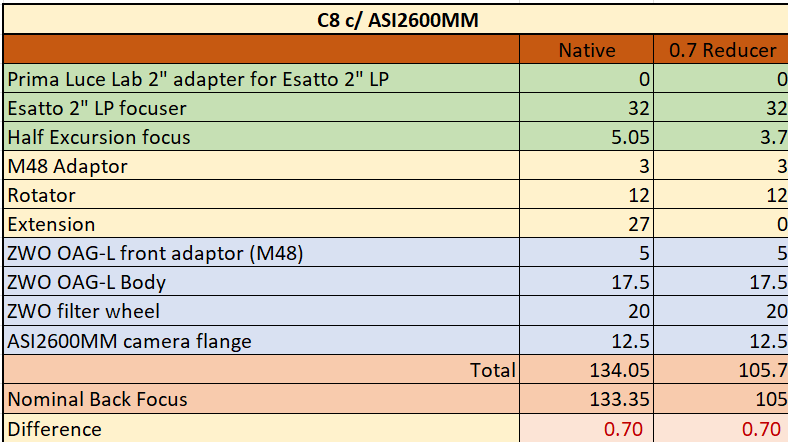 And the OAG-L with 36mm EFW and ASI2600MM (no tilt plate). The black tape on the EFW/Camera joint and on the base of the EFW is to prevent light ingress during the taking of flats in the mornings. The guide camera, once focused, never needs to be touched again. 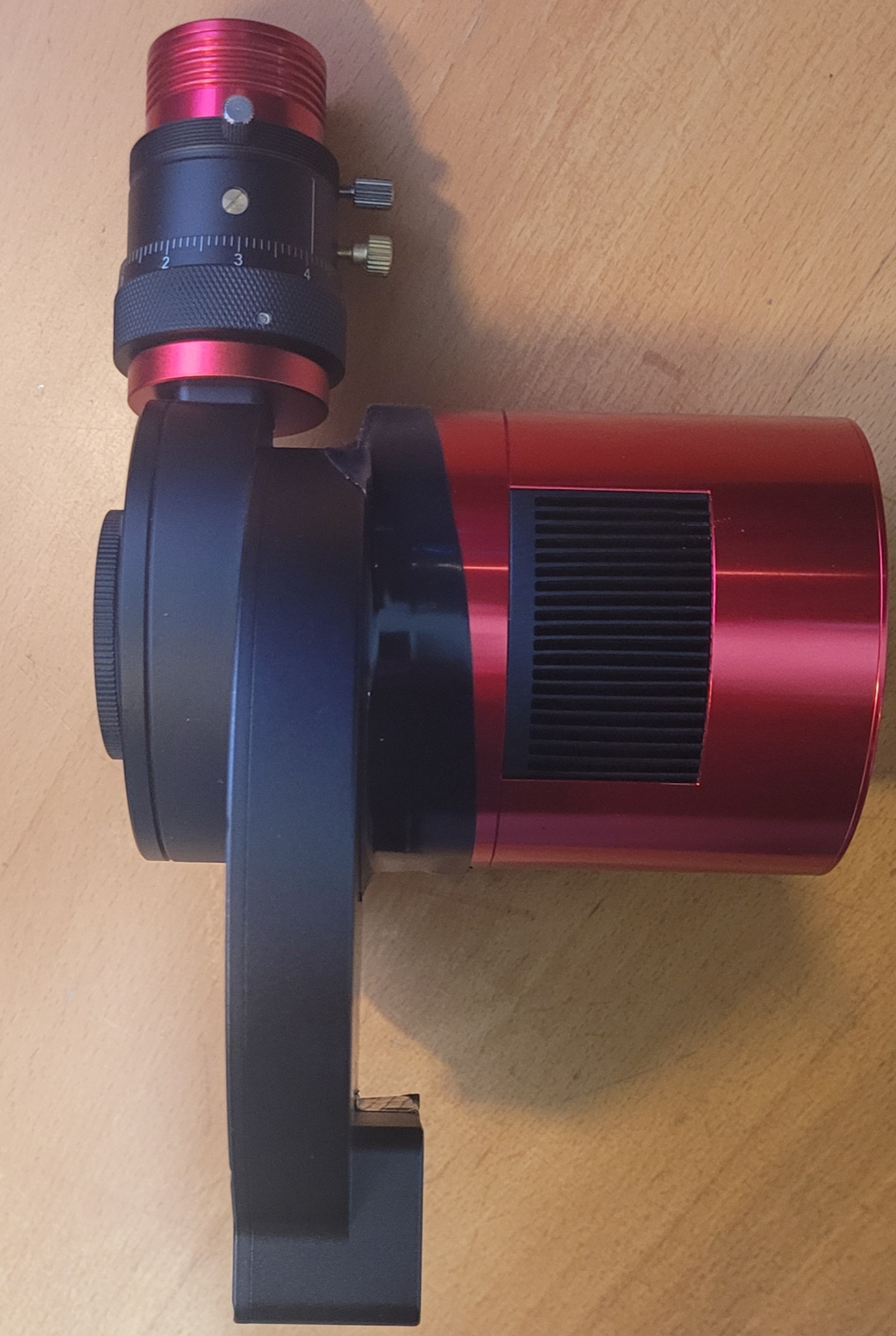 Cheers. Paul
|
You cannot like this item. Reason: "ANONYMOUS".
You cannot remove your like from this item.
Editing a post is only allowed within 24 hours after creating it.
You cannot Like this post because the topic is closed.
Copy the URL below to share a direct link to this post.
This post cannot be edited using the classic forums editor.
To edit this post, please enable the "New forums experience" in your settings.
I don't mind at all that backfocus was introduced to the topic. My challenges with astrophotography have been really enjoyable and fun–with my 2 refractors. But with the Edge, even my wife asks me why am I frustrating myself over a hobby. I am not sure whether the OCAL really doesn't work very well, the manual and online videos are horrible, the company that makes OCAL apparently doesn't have a professional translator working on their manual or videos and tech support is of little help.
There could be something wrong with my brand-new Edge and OCAL is fine. As shown in the OP, the images show that the red circle cannot be centered even though the crosshairs, blue and green circles are centered. This may indicate that there's a problem with the Edge itself. As soon as I can, I'll try collimating without the reducer under the natural sky, which should provide a smoother light source than what I've been using indoors.
Since Paul brought up focusing, I'd like to say that manual focusing with my refractors and a Bahtinov mask is a real pleasure. I get excellent, crisp, small, round stars and it takes me about 1 minute to dial in the centered spikes with the Bahtinov mask. Then I use the focus lock on either refractor and I'm pretty much good for the entire session. With the Edge, I get no pleasure at all. The ZWO EAF takes 10 minutes to find best focus and it also stops me from using the stock manual focuser. Since the Edge has no focus lock (mirror locks instead) I have no idea whether I'll have to continue focusing through the night. If the Primaluce focuser can focus both electronically and still allow for the use of the manual focus, that's probably what I will try next. Or maybe just ship the Edge back to Celestron and let them fix it so I can use the OCAL. I think I am highly allergic to standing out in the cold trying to collimate on a fast moving star. It is a part of this pursuit I just don't want to do anymore.
I have a 130mm refractor getting set up at a dark sky site in New Mexico. I can only image about once a month in my backyard as I live in San Francisco, California and the fog and wind are pretty much a constant all year around.
Jerry
|
You cannot like this item. Reason: "ANONYMOUS".
You cannot remove your like from this item.
Editing a post is only allowed within 24 hours after creating it.
You cannot Like this post because the topic is closed.
Copy the URL below to share a direct link to this post.
This post cannot be edited using the classic forums editor.
To edit this post, please enable the "New forums experience" in your settings.
Many things distort our images, but back focus errors usually have a indicator. They usually are radial from the center getting more distorted (strange Airy disk) outward from center. If they are more distorted on one side most likely you have a tilt issue. Some of my group are fanatical about back focus on SCTs, some are not. But what is in common, the pay attention to everything and have very long integration times. In fact, we have an integration UNIT called a Struble (30 hours) named after Doug Struble. When asked about exposure, one may answer Two Strubles (60 Hr.). Also, when I focus for imaging I focus 1/3rd. from the center, giving me maximum area of sharp focus. Chris
|
You cannot like this item. Reason: "ANONYMOUS".
You cannot remove your like from this item.
Editing a post is only allowed within 24 hours after creating it.
You cannot Like this post because the topic is closed.
Copy the URL below to share a direct link to this post.
This post cannot be edited using the classic forums editor.
To edit this post, please enable the "New forums experience" in your settings.
@Jerry Gerber did you get a hold of your serial number for the software? It sounds a lot like how mike behaved before I got it set up properly. I'll have a look on my laptop, I think I saved the necessities permanently. Edit: Wrote from my phone but will add a bit more now that I'm on my laptop. I found the Ocal websites horrible as well, but luckily I knew someone ho had the necessary files in order to make mine work. I experienced the same as you at first, just slightly off no matter what I did. I have the software itself along with a spreadsheet you have to use in order to get your center calibration code. 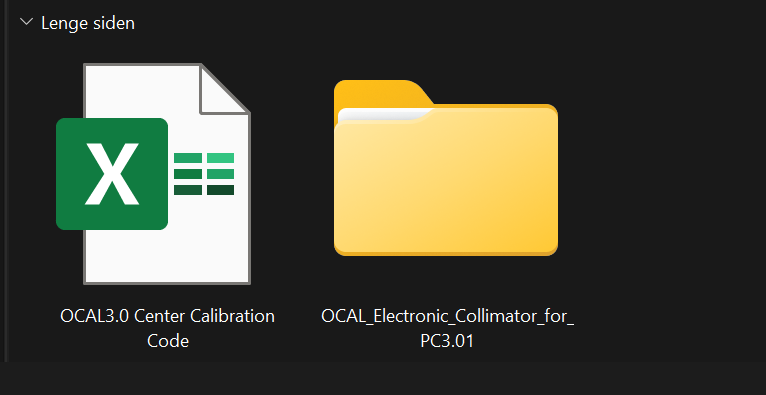  |
You cannot like this item. Reason: "ANONYMOUS".
You cannot remove your like from this item.
Editing a post is only allowed within 24 hours after creating it.
You cannot Like this post because the topic is closed.
Copy the URL below to share a direct link to this post.
This post cannot be edited using the classic forums editor.
To edit this post, please enable the "New forums experience" in your settings.
As of focusers for the 8 EdgeHD - I tried several including PrimaluceLab, Celestron; the only one that I found "perfect" was Moonlight's CHL 2.5 inch. Great with and without the focal reducer, and allows manual focusing as well. It does help for collimation.
|
You cannot like this item. Reason: "ANONYMOUS".
You cannot remove your like from this item.
Editing a post is only allowed within 24 hours after creating it.
You cannot Like this post because the topic is closed.
Copy the URL below to share a direct link to this post.
This post cannot be edited using the classic forums editor.
To edit this post, please enable the "New forums experience" in your settings.
@Jerry Gerber did you get a hold of your serial number for the software? It sounds a lot like how mike behaved before I got it set up properly. I'll have a look on my laptop, I think I saved the necessities permanently.
Edit: Wrote from my phone but will add a bit more now that I'm on my laptop.
I found the Ocal websites horrible as well, but luckily I knew someone ho had the necessary files in order to make mine work. I experienced the same as you at first, just slightly off no matter what I did. I have the software itself along with a spreadsheet you have to use in order to get your center calibration code.

 Yes, I entered the serial number code into the "Focus" txt file as directed.
|
You cannot like this item. Reason: "ANONYMOUS".
You cannot remove your like from this item.
Editing a post is only allowed within 24 hours after creating it.
You cannot Like this post because the topic is closed.
Copy the URL below to share a direct link to this post.
This post cannot be edited using the classic forums editor.
To edit this post, please enable the "New forums experience" in your settings.
Jerry Gerber:
With the Edge, I get no pleasure at all. The ZWO EAF takes 10 minutes to find best focus and it also stops me from using the stock manual focuser. Since the Edge has no focus lock (mirror locks instead) I have no idea whether I'll have to continue focusing through the night. If the Primaluce focuser can focus both electronically and still allow for the use of the manual focus, that's probably what I will try next. I had the ZWO EAF and whilst it's good on my small refractor (William Optics Zenithstar81), it was not convenient on the C8 - you have to use the hand controller for manual focus; can't use knob (same issue on Z81). With the Prima Luce, the mirror knob can still used as normal and the EAF used independently. It's also a joyful thing to hear the clean, precise operation and it focuses in under 5 minutes on my setup. I have the Prima Luce Sesto Senso on my Esprit 120ED (focuses in under 3 minutes on this setup). Same clean, crisp operation and you can still manually focus with the focuser connected. These focusers are not cheap but they are wonderful pieces of kit.
|
You cannot like this item. Reason: "ANONYMOUS".
You cannot remove your like from this item.
Editing a post is only allowed within 24 hours after creating it.
You cannot Like this post because the topic is closed.
Copy the URL below to share a direct link to this post.
This post cannot be edited using the classic forums editor.
To edit this post, please enable the "New forums experience" in your settings.













